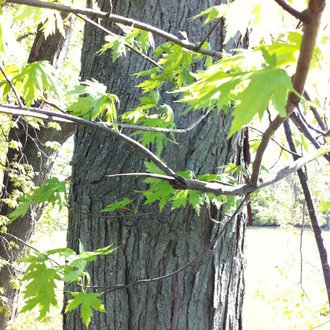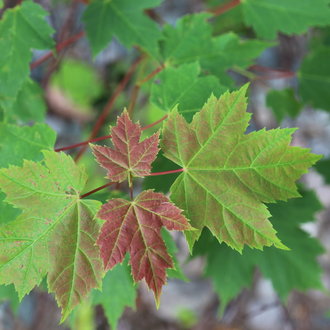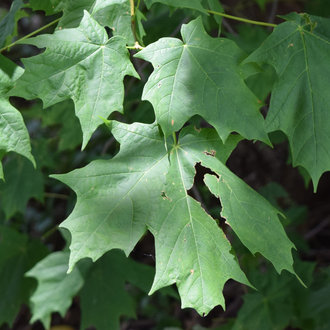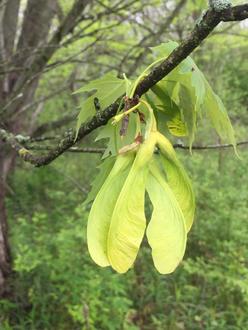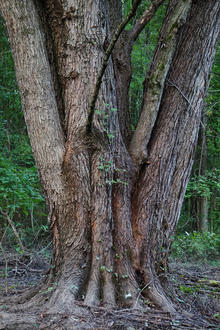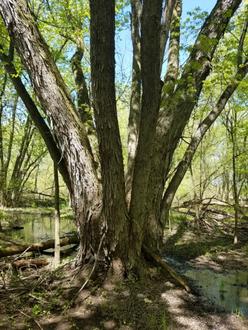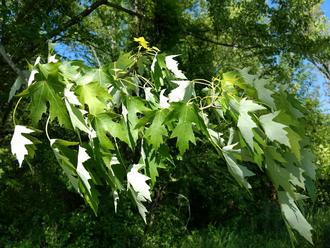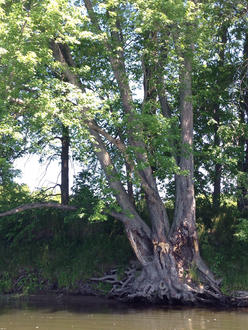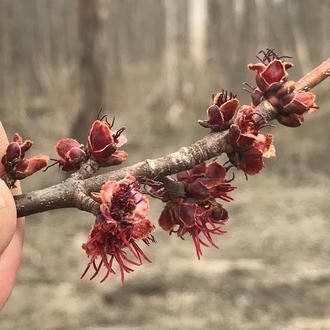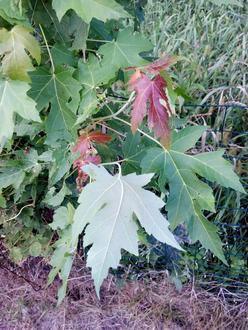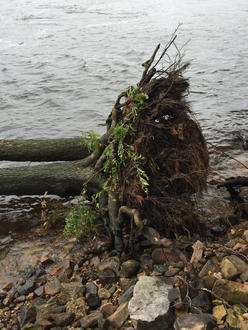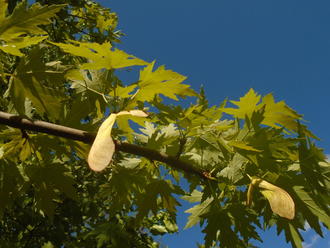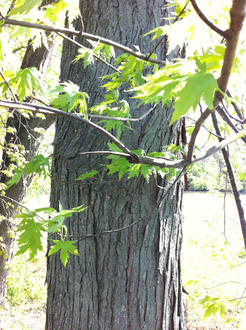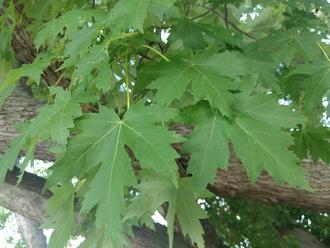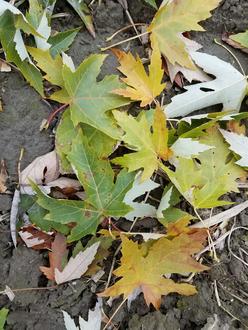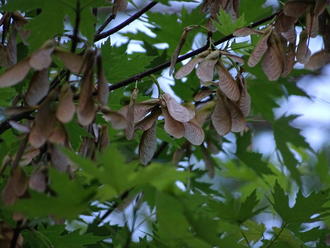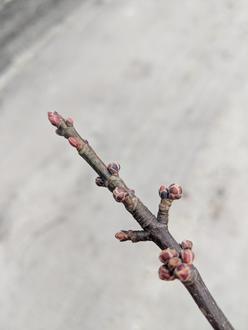Silver Maple (Acer saccharinum L.)
↑Summary
A maple with deeply-lobed leaves, named for the silvery color of the backside of its leaves. Native to North America; common in floodplains and along rivers.
↑Range - Expand
| Legend | Color |
| Native | |
| Introduced | |
| Native or Not Present | |
| Introduced or Not Present | |
| Native or Introduced |
This tentative map is based on our own research. It may have limited data on Canada and/or Mexico, and there is some subjectivity in our assignment of plants as introduced vs. expanded. Read more in this blog post.
Although this plant occurs somewhere in each of these regions, it may only occur in a small part of some or all of them.
This species has been widely introduced in the west through landscaping use. We consider all populations from Colorado and New Mexico westward introduced; although the CO and NM populations are not far from this species' western range limits, we saw no evidence that this species is expanding westward at its limit; rather these are isolated introductions from landscaping plants, across divides of habitat where this species probably could not occur.
↑Similar Plants
↑Habitat
Almost exclusively limited to wet bottomlands. Found especially in floodplains along rivers, streams, and moving water, also sometimes at lake margins. Trees often grow right up to the water's edge. Less frequently found in wetlands with stagnant water. Also occurs in disturbed, small fragments of forest in cities, along railroads, roadways, and industrial areas, especially in areas prone to flooding from streams or rivers, and resembling its natural habitat. Mostly found at low elevations and becomes less common as elevation increases.
Although it can survive on drier sites, it is not found on them in the wild due to its poor ability to compete with other species better suited to these sites.
Easily killed by fire and limited to sites free of fire.
↑Life Cycle
Sprouts from seed, usually in summer to fall, but sometimes spring as well. Seedlings can survive in saturated soil, especially if initially given a chance to establish before flooding begins, but perform best when soil is not fully saturated.
Begins producing seed at 11 years of age at the earliest. Seed production is consistent from year to year. Flowers very early, in late winter to early spring, with seeds maturing in spring to early summer.
Seeds are dispersed mostly by wind, with water playing a supporting role for some seeds. Seeds are strongly attached and typically only released in high winds, leading the relatively large seeds to travel farther than is typical for maples. Seeds are usually released during a period of about 2 weeks.
Seeds germinate immediately and do not require cold stratification, and most will germinate immediately if conditions are right. However, some seeds may survive the winter and not germinate until the following spring, especially in northerly climates. If seeds are buried, they germinate underground and only send up shoots later. However, seeds germinating on bare soil spread their cotyledons and use them as photosynthetic structures. Germination is best on moist mineral soils with considerable organic matter, but seeds can also germinate in dense leaf litter.
A fast-growing tree, the wood is brittle and weak. Often grows with multiple trunks, or branches low on the trunk into multiple, heavy branches. Young trees resprout prolifically if mechanically damaged. The root system is also able to quickly regenerate if damaged by prolonged periods of flooding. However, the thin bark and shallow root system make this tree easily killed by fire.
Trees can live up to 130 years, possibly longer, but many trees are short-lived.
↑Faunal Associations
The buds of silver maple, which are quite large, are an important food source for squirrels in the early spring, when stores of winter nuts are becoming exhausted but other food sources have not yet emerged.
The weak wood, prone to rot, combined with the large, thick branches of this tree, creates convenient nesting sites for cavity-nesting birds.
The seeds are an important food for larger birds as well as squirrels and chipmunks. The foliage is eaten by deer and rabbits, and the bark is eaten by beavers.
The upper branches of large trees are sometimes used as a communal roosting site for various native species of blackbirds as well as European starlings.
Like other native maples, this species supports numerous insect herbivores, including many moths, leafhoppers, aphids, beetles, and scale insects. Honeybees gather pollen from the flowers, but are not important in pollination, as the pistillate flowers lack nectar and are not visited by bees.
↑Uses
Occasionally planted as a street tree or a shade tree, where it is favored for its rapid growth habit, attractive foliage, and tolerance of urban conditions. However, poorly suited for planting near streets or buildings because of the tendency of this species to drop large, heavy limbs that can harm people and property. It is also prone to branching low down on the trunk or growing with multiple trunks, and the roots are prone to heaving sidewalks.
Red maple (Acer rubrum) is almost always a better choice in urban and suburban conditions, because of the single-trunk growth habit and lower propensity to drop heavy limbs, and that species is also more drought-tolerant, is fast-growing, and has attractive fall color.
A fairly important timber species, where it is typically grouped together with red maple and sold as "soft maple".
↑Related Plants
Closely related to the red maple (Acer rubrum), with which it hybridizes, forming the Freeman maple. These hybrids are naturally occuring, but human influence has increased the degree to which these plants grow in close proximity, causing them to occur more frequently. The red maple occurs in a much wider range of habitats than this species; among low-lying wet areas, it is more likely to be found near stagnant water whereas this species prefers areas near moving water.
Numerous other maple species, including both native and introduced species, occur in the same range, although in the wild, most of them occur in more upland habitats. Box-elder, (Acer negundo), sometimes co-occurs in the same open floodplain habitat.
↑Links & External Resources
• Silver Maple | The Wood Database (About This Site)
• Silver Maple | Fire Effects Information System (FEIS) (About This Site)
• Acer saccharinum (Silver Maple) | Illinois Wildflowers (About This Site)
• Acer saccharinum (Silver Maple) | USDA PLANTS Database (About This Site)
• Acer saccharinum | Go Botany (About This Site)
• Acer saccharinum (Silver Maple) | Missouri Botanical Garden Plant Finder (About This Site)
• Silver Maple | Virginia Tech Dendrology Factsheets (About This Site)
• Silver Maple | Silvics of North America (About This Site)
• Acer saccharinum | Biota of North America Project (BONAP) (About This Site)
• Acer saccharinum | NatureServe Explorer (About This Site)
• Silver Maple | Maryland Biodiversity Project (About This Site)
• Acer saccharinum L. (Silver Maple) | Digital Atlas of the Virginia Flora (About This Site)



